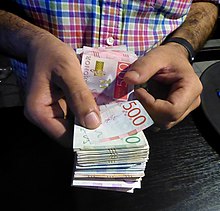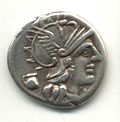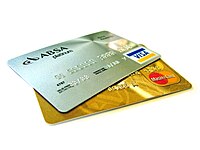Money
Money is any asset or good generally accepted as a means of payment by economic agents for their exchanges and that also fulfills the functions of being a unit of account and store of value. Some examples of money They are: coins, currency and bills, debit and credit cards, and electronic transfers, among others.
Money as we know it today (bills and coins with no value of their own) must be endorsed or certified by the issuing entity. For its acceptance, it needs the construction of mechanisms of legitimacy and trust. Currently, it is governments, through laws, who determine what type of money is legal tender. But it is other entities, such as the central banks and the mint, which are in charge, first, of regulating and controlling the monetary policy of an economy, and second, of creating coins and bills according to demand and the need to have physical money in circulation. From a Social Sciences point of view, the social factor comes into play since currency, being "a public good", insofar as it provides services of this nature, must be regulated by public authorities (through central banks) as representatives of the public interest, and not only through market mechanisms.
Etymology
The term "money" derives from the name of the Roman silver coin, denarius. It was worth ten ases. It would derive from the Latin distributive adjective deni ('every ten'), in turn, derived from the numeral decem ('ten').
It was the name of various coins used during the Middle Ages in almost all the kingdoms of Spain, France and Byzantium. Likewise, the dinar used in several current Arab countries share the same Latin etymology.
Currently in Spanish-speaking countries, «dinero» carries the meaning of «current currency».
History
Between the different cultures of the world, a wide variety of materials and objects have been used with the function that today we are used to seeing with coins, bills, credit cards, checks or checks, etc. It may seem true, in many cases, which is related to the exchange of merchandise that human beings have been using since prehistory: barter.
Barter
In the Neolithic, with the appearance of agriculture and livestock, the first production economy appeared and a surplus was produced; a quantity of goods that need not be consumed. This gave rise to the possibility of also feeding people who did not need to work agriculture or livestock for their own subsistence, and who could therefore dedicate themselves to producing other products, such as ceramics or weapons, and exchange them for the surplus produced. This allowed the first form of trade, barter, directly exchanging goods and services for others, based on the consensus of the participants about the value of the objects to be exchanged. Over time, this form of exchange was considered inefficient.
However, today it continues to be the basis of exchange in moments of great scarcity (for example, due to war conflicts or catastrophes) leading to black market situations, and the essence of the operation of time banks that have emerged in local level in many places, in different countries and at different times.
Metals
Over time, gold and silver were the most widely used precious metals as money due to their value being accepted worldwide, and also due to ease of transportation, preservation advantages, etc.. To guarantee or certify that a piece of metal or coin contained a certain amount of gold and/or silver, minting began, by way of guarantee or certification, by recognized and respected entities (kingdoms, governments, banks), that guaranteed the weight and quality of the metals they contained.
According to Herodotus, the Lydian people were the first to introduce the use of gold and silver coins, and also the first to establish exchange shops in permanent premises. It is believed that they were the first to mint stamped coins, during the reign of Gyges, in the second half of the 7th century BC. C. Other numismatists date the coinage back to Ardis II. The first coin was made of electro (alloy of gold and silver). with a weight of 4.76 grams, in order to be able to pay the troops in a regulated manner. The motif of the stamping was the head of a lion, the symbol of royalty. The Lydian standard was 14.1 grams of electro, and was a soldier's pay for a month's service; this measure was called stater.
But bronze, copper, iron, even lead, have also been some of the metals frequently used for minting coins.
Types
Merchandise money
Sometimes called real money, 1 is that kind of money whose value, unlike representative money and fiat money, comes mainly from the good of which it is composed. Good money consists of goods or objects that have value for themselves, in addition to the exchange value when used as currency.
Representative money
Type of money that, unlike the money commodity, is based on another asset, such as, for example, money backed in gold, silver, oil or other currency, which has the quality of being convertible to the asset to which it represents, which can be a kind of metal money.
Fiat money
Also known as money by decreeIt is a form of money without intrinsic value. Their value is based on their declaration as money by the State. The term fíat is often used interchangeably with that of trust money, however the terms are not equivalent and the nuance can be considerable. Fiat money is the type of money of the dollar, euro, yen and major international currency.
Fiat money
The money called Trust (from Latin) fiduciarOf Fiji 'confidence' and this in turn fides 'faith'), it is based on the faith or trust of the community, that is, it is not supported by precious metals or anything other than a promise of payment by the issuing entity.1 It is important to bear in mind that we understand the trust of the community as the whole of the apparent wealth presented by the currency broadcasting community. It is the monetary model that currently dominates the world, and it is the US dollar, the euro and all other reserve currencies.2
Currency
La currency is a piece of a resistant material, of uniform weight and composition, usually of metal coined in the form of disk and with the distinctive chosen by the issuing authority, which is used as a measure of change (money) for its legal or intrinsic value and as an account unit.
Paper money
The oldest preserved paper ticket was manufactured by the Ming dynasty, about 1375 and was equivalent to 1,000 copper coins.
There was a need for an evolution in which the states issued notes and coins, which gave their carrier the right to exchange them for gold or silver from the country's reserves. Changes in economic dynamics during the twentieth century ended metal hegemony in money, which took other aspects (billetes, cards, etc.), The evolution of the backing of the paper currency is as follows:
- In the 18th and 19th centuries, several countries had a pattern of two metals, based on gold and silver.
- Between 1870 and the First World War, the Gold Pattern was adopted mainly, so that any citizen could transform the currency paper into an equivalent amount of gold.
- In the period between world wars, it was sought to return to the Golden Pattern, although the economic situation and the crisis or the 29th cramp ended with the convertibility of the gold tickets for individuals.
- At the end of the Second World War, the allies established a new financial system in the Bretton Woods Agreements, in which it was established that all currencies would be converted into US dollars and only the US dollar would be converted into gold ingots at $35 per ounce for foreign governments.
- In 1971, U.S. expansive fiscal policies, mainly motivated by Vietnam’s military spending, provoked the abundance of dollars, casting doubts about their convertibility into gold. This made central European banks attempt to convert their dollar reserves into gold, creating an unsustainable situation for Americans. In response, in December 1971, the President of the United States, Richard Nixon, unilaterally suspended the convertibility of the dollar into gold for the public and devalued the dollar by 10%. In 1973, the dollar is again devalued by another 10%, until, finally, it ends with the conversion of the dollar into gold also for foreign central governments and banks.
- Since 1973 the money used in the world has a value that is in the subjective belief that it will be accepted by the other inhabitants of a country, or economic zone, as a form of exchange. Monetary authorities and Central Banks do not intend to defend any particular level of exchange rate, but they intervene in the foreign exchange markets to soften short-term speculative fluctuations, with the aim of maintaining in the short term the stability of prices, and avoiding situations such as hyperinflation, which make the value of that money destroyed, by disappearing confidence in it, or as deflation.
Electronic money
The electronic money (also known as e-money, electronic cash, electronic currency, digital money, digital cash or digital currency) refers to money which, or is broadcast electronically, through the use of a network of computers, Internet and digitally stored values systems such as the Bitcoin case, or is an equivalent digital payment means of a certain currency, as in the case of Ecuador or Peru Electronic transfer of funds and direct deposits are examples of electronic money.
Functions
Money is a neutral or fully liquid financial asset, which serves as an intermediate platform to optimize the exchange of goods and services, avoiding the inaccuracies of barter, that is, the direct exchange of goods and services. Therefore, for a good to be qualified as money, the following three criteria must be satisfied, which are the three main functions that money fulfills in a modern economic system (functions that Aristotle already defines in his book Nicomachean Ethics). similar way a few centuries earlier):
- Means of exchange: to avoid the inefficiencies of a barter system. When a good is required with the sole purpose of using it to be exchanged for other things, it owns this property. In addition, money must be a light and easy to store and transport good.
- Accounting Unit: When the value of a good is often used to measure and compare the value of other goods or when its value is used to denominate debts, it is said that the good possesses this property. The unit of account means that it is the unit of measure used in an economy to fix prices.
- Conservation of value: When a good is acquired with the aim of preserving the commercial value for future exchange, then it is said to be used as a deposit of value. Money is a deposit of value but not the only one, any asset that maintains its purchasing power over time will serve as a deposit of value.
Offer of money
The money supply or monetary supply, in macroeconomics, is the amount of money available in an economy to buy goods, services and savings securities, at a given time. certain. The money supply is jointly determined by the private banking system and the country's central bank. The central bank operates through the open market and other instruments to provide reserves to the banking system.
Money and the liquidity of assets
Anyone can create their own money. For example, in retail stores with the issuance of purchase vouchers, but this type of money has a drawback, that it is only accepted by the same store that issued them, so their liquidity is very limited.
The only type of money properly so-called that is legally considered as such is that issued by central banks (bills and coins), also called legal money, and it must always be accepted as way to pay. Legal money is considered to be the most liquid asset to which all other assets (goods, services, debts or obligations) can be converted and vice versa.
In a broad sense, there is much more to money than just legal money. There are different types of financial assets that constitute money in the broad sense; They can be classified according to their degree of liquidity. Money in the strict sense would only be fully liquid. To start talking, the amounts in current bank accounts or sight deposits must also be considered as money convertible into legal money in a 1:1 ratio, immediately; These depositors will have their money through their current account checkbook, but the depository bank, in the exercise of its commercial activity, will deliver it to a third party who will be able to dispose of it with another checkbook, that of a credit account. In this way, deposit institutions and, in general, all credit institutions, multiply legal money (cf. creation of bank money, quasi-money).
When a cash deposit is made in a checking or sight account, the bank's Assets (Treasury) increases but, also, an accounting entry appears in the Liabilities to represent the debt of that amount of money with the depositor. From the point of view of the latter's assets, what has happened is a change of a fully liquid asset (legal money) for a maximum liquidity credit right against the depositary bank, since there is a commitment by the bank to convert it in legal money at the request of the depositor. With the legal money deposited by the passive clients, the bank does its business (cf. irregular deposit), lending a part to its active clients or investing it, but it must keep a part "in Cash" (Reserve) to be able to deal with eventual refunds.
What has been said in relation to checking accounts and sight deposits can be applied, with the corresponding variations, to savings deposits, time deposits and other financial assets issued by the financial system. The complete classification of financial assets, from greater to lesser liquidity, grouped into the so-called monetary aggregates, is nothing more than the orderly way of referring to the Monetary Supply.
It should be added that, like banks, companies can also issue negotiable debt securities that can be considered a special type of quasi-money. These types of issues are called in various ways, for example, commercial paper (endorsable bills of exchange), but they are not part of any of the monetary aggregates, reserved for the financial system. Part of the doctrine calls "financial money" to this set of non-bank financial assets. From the material point of view, there is no doubt about its monetary nature; think, for example, of mechanisms such as the pledge of securities or that, with the listed shares of a company, shares in other companies can be directly acquired, as is often seen.
Creating money
In current economic systems, money is created by two procedures:
- Legal money, it is the one created by the Central Bank by coining and printing notes, is cash. The amount of legal money is measured by M1.
- Bank money, it is created by private banks by annotation in account of credits as deposits of borrowers, with a partial backing indicated by the coefficient of cash. Normally banking money is now created as electronic money. The amount of bank money is measured by monetary aggregates other than M1.
The amount of money created is measured by monetary aggregates. The current way of creating and controlling the amount of money is inspired by monetarism.
Money backing
It is considered that the value of money should be backed in precious metals (gold, silver, etc.) or in foreign currencies; however, neither of these methods is certain, considering that its value is subject to supply and demand, and there can be no guarantee that large mineral reserves of the metal will not suddenly be discovered or an application will be generated that increases its demand. The same is true of currencies. Since money is not currently backed by any tangible asset, it is called fiat money. Doctrine has questioned both the gold backing and the law of supply and demand relationships in the value of money.
In fact, money is the result of a social pact, where everyone agrees to deliver their goods or services to others, in exchange for monetary symbols (bills, coins, etc.); therefore, the support of money is the sum of the goods and services of the Population; that is, the gross domestic product or GDP.
The government must prevent the growth of the monetary aggregate from being uncorrelated with that of the GDP, in order to sustain its value. However, the government can choose to print more banknotes, which would lead to inflation and the devaluation of its currency, as a way of reciprocally financing itself.
Contenido relacionado
Columbine High School massacre
Peru coffee
Salasaka








